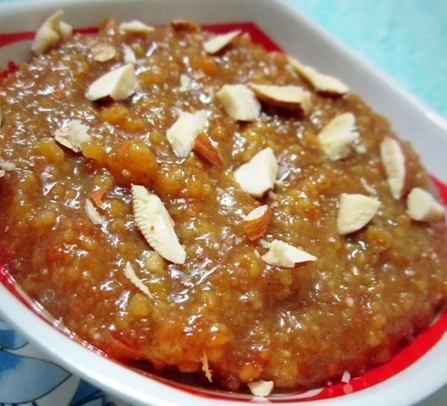Mama’s Punjabi Recipes- Besan da Halwa (GRAM FLOUR PUDDING)

Besan da halwa (gram flour pudding) is as Punjabi as you can get as this is one of the favorite sweets eaten during the cold winter months and especially during the festivals. The aroma of chickpea flour roasting in ghee fills the whole house and this is an important indication that the chef knows what he or she are doing: if the besan is left undercooked, it will give a raw, gritty taste.
Besan (roasted gram flour or garbanzo flour or chickpea flour) is a flour that is commonly used all over India to make pakoras or fried fritters, a common Indian comfort food. Besan is also used to make kadhi, boondi (besan fried drops), laddus (sweet balls), besan ki barfi (sweetened flat cake) or poode (salty pancakes). After wheat, besan is the second most often used flour in Indian cuisine, though it is used only in a few dishes which are made sweet.
Besan is high in carbohydrates and somewhat high in protein and has no gluten, which makes it not suitable for those trying to lose weight (especially when it is fried). Besan is rich in folate, iron, magnesium and phosphorous as well as thiamin and vitamin B6. Besides these attributes, besan also makes an excellent scrub and mask for skin care and can also help in fighting seasonal allergies during the cold months.
Both besan and sooji (semolina) need a lot more water than atta (wheat flour) when being prepared as the grains soak it up. This is why, if you prefer a thinner halwa, just increase the water by one cup.
Ingredients:
• 1 cup besan (coarse gram flour)
• 1 cup peessi hui chinni (powdered sugar)
• 1 cup tael (vegetable oil) or ghee (clarified butter)
• 3 cup pani (water)
• ½ tsp illachi (cardamom) powder
• Mewah (dried fruit) to taste: 1 cup badam (almond) and piste (pistachios) pieces or blanched split almonds
Directions:
1. To make the chasni (syrup), bring the water to a boil in a medium saucepan. Pour in the sugar and illachi powder, stirring till they are completely dissolved. Keep the mixture to the side for later use.
2. Pour the oil or ghee in a wok or kadai and warm for a few minutes over low heat.
3. Pour the besan in and stir continuously for about 10 minutes over medium heat so that it does not start to burn.
4. Add the almonds and pistachios, mix well and continue to stir over low heat to roast the mixture and it is turns slightly brown.
5. Slowly pour in the syrup into the besan, stirring continuously as you don’t want to have the besan to get too brown as it may give a burnt smell. Don’t brown over high heat as the besan.
6. When the oil or ghee starts to percolate up along the edges and to the top then turn the heat off.
7. When the halwa cools down it will thicken. If you want it thinner, add 4 cups of water instead of 3.
MAMA’S TIP OF THE WEEK: TO CALM YOUR NERVES, TRY SOME HOT SUANF (FENNEL) CHAI
Dried saunf (fennel seeds) are often used as a digestive and mouth freshener after a meal but are also often used in cooking Indian sweet dishes when mixed in the dough of some puddings. Fennel seeds have many benefits ranging from relieving congestion and stomach gas to asthma and diabetes. They contain powerful phytonutrients and antioxidants especially anethole.
In addition, fennel seeds have a calming effect when taken as a hot drink instead of tea or coffee which contain lots of caffeine which can stimulate your body and, as a diuretic, can make your kidneys work. Simply boil some fennel seeds in water, then let the mixture sit for a few minutes before drinking it. No need to add sugar or milk.

Shakuntla Malhotra is a skilled cook of Punjabi dishes made in the old-fashioned style that she learnt as a young woman in her ancestral home in Lyallpur, India (since renamed Faisalabad) before it became part of Pakistan after the Partition in 1947. People have often admired her cooking for its simplicity and taste that comes with each mouthful. Even in her late-eighties, she continues to cook daily and agreed to share her delectable Punjabi recipes for future generations.
